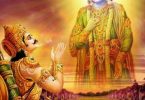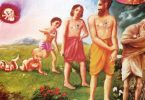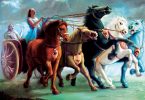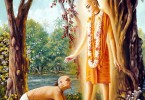Context class link to the questions: https://youtu.be/13lpQO-85ig?t=1580
Question1: In the śloka ete cāṁśa-kalāḥ puṁsaḥ kṛṣṇas tu bhagavān svayam, in the purport SP writes, “The godly living beings who are all residents of the planets in the spiritual sky are eternal associates of God in different spiritual planets called Hari-dhāma and Maheśa-dhāma.” Does this Maheśa-dhāma fall in the spiritual category? If somebody goes to Maheśa-dhāma, will he not come back to this material world? Kṛṣṇa says in Bhagavad Gita that one who goes to Vaikuntha, he does not come back to this material world [BG 8.21]. In the same way, this Maheśa-dhāma is there. If somebody goes there Maheśa-dhāma, will he come back?
Answer by Romapada Swami:
The excerpt from SB 1.3.28 purport quoted in the question is aligned with Brahma-saṁhitā 5.43 text and purport. Maheśa-dhāma, in this context, is outside of the material world (Devī-dhāma) but is not part of the Vaikuṇṭhaloka (Hari-dhāma).
Whether or not one comes back to the material world after reaching Maheśa-dhāma depends on one’s consciousness and purpose. Additional references for who would come to Maheśa-dhāma can be found in Light of the Bhāgavata verse 47 commentary as well as Cc Madhya-līlā 21.54 purport.
SB 1.3.28 purport last paragraph: The godly living beings who are all residents of the planets in the spiritual sky are eternal associates of God in different spiritual planets called Hari-dhāma and Maheśa-dhāma.
BS 5.43 purport – ~~~ Next above Devī-dhāma is located Śiva-dhāma one portion of which, called Mahākāla-dhāma, is enveloped in darkness; interpenetrating this portion of Śiva-dhāma there shines the Sadāśivaloka, full of great light. Above the same appears Hari-dhāma or the transcendental Vaikuṇṭhaloka. The potency of Devī-dhāma, in the form of the extension of Māyā, and that of Śivaloka, consisting of time, space and matter, are the potency of the separated particles pervaded by the penumbral reflection of the subjective portion of the Divinity.
Light of the Bhāgavata verse 47 purport: – The conditioned living entities who wish to enjoy and not serve are given a chance within Devī-dhāma to seek liberation. Some of them enter Hari-dhāma, some of them enter Maheśa-dhāma, and some of them remain within Devī-dhāma. Maheśa-dhāma is the marginal place between Hari-dhāma and Devī-dhāma. The impersonalists who want to merge into the existence of the Transcendence are placed within Maheśa-dhāma. Those who want to remain within the planetary systems of the material universes do so on various planets. But those who want to go outside the material energy can enter Hari-dhāma and go either to the various planets there or directly to Kṛṣṇaloka. The system of bhakti-yoga makes one eligible to enter Hari-dhāma, the system of jnāna-yoga makes one eligible to enter Maheśa-dhāma, and the system of karma-yoga obliges one to remain in Devī-dhāma and repeatedly be born and die, changing his material covering according to the standard of karma he performs.
Cc Madhya-līlā 21.54 purport: – When a living entity is liberated from Devī-dhāma but does not know of the opulence of Hari-dhāma, he is placed in Maheśa-dhāma, which is between the other two dhāmas. The liberated soul does not get an opportunity to serve the Supreme Personality of Godhead there; therefore although this Maheśa-dhāma is Lord Śiva’s dhāma and above Devī-dhāma, it is not the spiritual world. The spiritual world begins with Hari-dhāma, or Vaikuṇṭhaloka.
Question2: Regarding the same question, I was looking at the universal creation poster. There is a spiritual world. There, the Kārana Ocean is depicted. Below this, there is a material world. Just above the Kārana Ocean, there is actually a realm or a loka called Sadāśiva. Are Sadāśiva Loka and Maheśa Loka different or the same?
Answer by Romapada Swami:
The universal creation poster mentioned in the question is derived from the same context discussed in the answer to Q1. In Brahma-saṁhitā 5.43 purport, Sadāśiva-loka is introduced as part of Maheśa-dhāma, and thus they are not equivalent.
Question3: When you said that Śiva is not an eternal jīva, we know the following calculation is clearly given regarding Brahmā: one day of Brahmā is one kalpa, or one thousand yuga cycles; Brahmā lives one hundred years. We have accurate calculation of how long he lives. For Śiva, do we have any calculations like that?
Answer by Romapada Swami:
Not that I am aware of. Note that Lord Brahmā’s life span is closely related to the duration of material universe and the cycle of material creation, whereas Lord Śiva is not. In terms of the tattva of Brahmā, Śiva, and jīva in the context of material creation, see Brahma-saṁhitā 5.49 purport for additional references.
BS verse 5.49 purport: – By principle Brahmā is superior to ordinary jīvas but is not the direct Divinity. The divine nature is present in a greater measure in Śambhu than in Brahmā. The fundamental significance of the above is that the aggregate of fifty attributes, belonging to the jīva, are present in a fuller measure in Brahmā who possesses, in a lesser degree, five more attributes which are not found in jīvas. But in Śambhu both the fifty attributes of jīvas as also the five additional attributes found in Brahmā are present in even greater measure than in Brahmā.
Question4: Lord Brahmā had given multiple places to Rudra for his residence. Are these the same “different abodes” that you talked about?
Answer by Romapada Swami:
Assuming it is SB 3.12.11 that is referenced in the question, the answer is NO. Rather, some of the “different abodes” of Lord Śiva are identified in the answer to Q5 below.
SB 3.12.11: [Lord Brahmā speaking to Rudra] “My dear boy, I have already selected the following places for your residence: the heart, the senses, the air of life, the sky, the air, the fire, the water, the earth, the sun, the moon and austerity.”
Question5: What happens to Lord Śiva’s abode during each night of Lord Brahmā? Does it endure? Or does Śiva appear at the beginning of each day of Brahmā? Is there an aspect of Lord Śiva within each universe that is annihilated at the end of each day of Lord Brahmā, or only at the end of the life of Brahmā?
Answer by Romapada Swami:
Since Lord Śiva has multiple abodes or residences, we would need to discuss the appropriate reply on a case-by-case basis. For example, in terms of Maheśa-dhāma discussed above, since it is outside of Devī-dhāma, it is not affected by the creation and destruction of material universes taking place within Devī-dhāma.
Alternatively, considering that everything up to Svargaloka is inundated with water at the end of Lord Brahmā’s day (SB 7.3.26-27, Purport), two of Lord Śiva’s residences (a) on Bhū-maṇḍala (SB 5.17.15) and (b) Vitala (SB 5.24.17) will be destroyed during the night of Lord Brahmā.
Another residence of Lord Śiva, for example, is within the false ego covering of the universe. VCT’s commentary to SB 10.89.52 “The abode of the expansions of Rudra is Rudraloka located within the covering shell of false ego, ahaìkära.”
Here is yet another detail: “Sometimes a special jīva takes the role of Śiva, in a manner similar to Brahmā.” (Laghu-bhāgavatāmṛta 1.2.27). From this perspective, it may be inferred there exists an aspect of Lord Śiva that is annihilated at least at the end of the life of Brahmā. SB 6.6.17-18 mentions ten million Rudras born of Sarūpā (daughter of Dakṣa in his second birth) and Bhūta (son of Bhṛgu in his second birth), of whom eleven are principle. However, these Rudras do not seem to be Lord Śiva or the eleven Rudras who are expansions of Lord Śiva.







